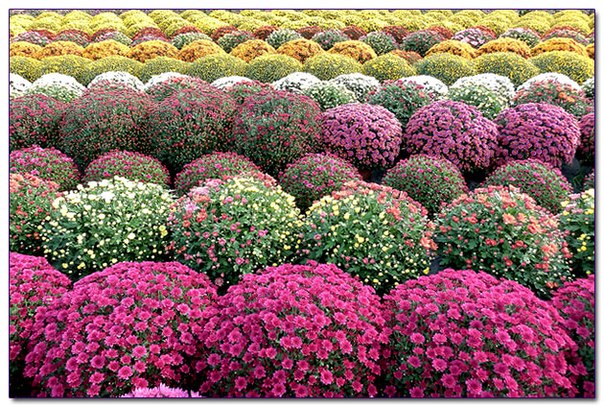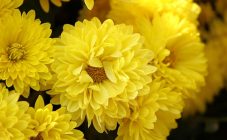Content:
Chrysanthemum spherical, or chrysanthemum Multiflora, refers to perennial ornamental plants. It got its name due to its appearance - many flowers, as they grow, form a regular ball, behind which leaves are practically invisible. The main feature of the plant is that to give this shape there is no need to cut it, artificially providing the required length of the stems, on the contrary, the flower itself initially grows into a certain rounded shape.
General information about the plant
The height to which spherical chrysanthemums grow depends on the selected variety. There are undersized, medium and tall plants of this species. However, the difference between varieties is not limited to height alone. There are over a thousand species of this plant, which differ in color.
This flower has several names that reveal its properties from different angles. In addition to the name that describes the appearance, that is, "chrysanthemum ball", there is also an indication of the origin - Chinese chrysanthemum. Almost all varieties of this plant are bred in China.
In order to maintain a rounded shape, this flower is grown from seedlings, since it is not always possible to get a bush of this type when propagating from seeds. Instead of a ball, the plant can simply stretch out in length.
Characteristic of Multiflora
Due to the wide variety of varieties, it is rather difficult to characterize this garden plant: its variations differ in appearance, height, color, flowering period and much more. Only form unites them.
These flowers are grouped according to the following criteria:
- growth;
- flowering period;
- coloring.
According to their growth, spherical chrysanthemums are divided into undersized (20-30 cm), medium-sized (from 30 to 40 cm) and tall, which can reach up to 70 cm. Plants from the first group can be grown in the open field and in a pot at home. But in the latter case, the success of flowering depends on the room temperature and the efforts of the grower.
According to the flowering period, chrysanthemums differ into those that bloom by the end of summer, in mid-September and by the end of September - early October.
In the case of a breakdown by color, everything is simple and clear: there are white, yellow, orange, purple, pink, red and other shades. In addition, the inflorescences on spherical bushes are usually small in size from 2 to 4 cm.
Despite the fact that some varieties bloom until frost, this plant does not tolerate low temperatures well, therefore, in order for it to successfully survive the winter, some effort must be made. There are 2 main methods for preparing a plant for wintering:
- sheltering;
- transplanting into a pot or flowerpot for further storage at home.
As for the covering, it is produced in any way convenient for the grower immediately upon the onset of cold weather. Flowers can be covered:
- special cloth;
- film;
- spruce branches;
- hay;
- any other material that is at hand.
However, it is important to remember that the covering material is removed immediately after warming - approximately at the end of April - beginning of May, so that the flowers do not spray.
Dwarf, low-growing bushes are often initially grown not in open ground, but in pots. In this case, you can display them directly in the container to decorate the garden, without resorting to transplanting. The method is convenient in that it does not require additional costs in time compared to the annual transplantation of flowers from the soil to the pot and vice versa. In addition, it is much easier to care for such chrysanthemums.
Popular varieties of Multiflora
Since, according to some sources, there are several thousand different varieties of this plant species, it is not possible to list them all. The most popular varieties among flower growers:
- Branbeach White belongs to early tall plants. Flowering time occurs in mid - late August. The variety is characterized by medium-sized white inflorescences.
- Branbeach Sunny is similar to Branbeach White, but its inflorescences are bright yellow as the sun.
- Branindio ripens early and can reach a height of 50 cm, which makes it a medium-sized species. Inflorescences are yellow with a slight orange-golden tint.
- Brandroyal Red belongs to tall varieties (it can grow up to 70 cm). The flowering period usually begins in early to mid September. The species Red has small (4-5 cm) dark red flowers.
- Brandroyal Yellow is similar to Red, but the flowers are bright yellow.
- Brandroyal White is distinguished by white flowers with a pale yellow heart.
- Bransky plum has pink-lilac flowers with a diameter of 4-5 cm.The variety blooms in September, and can reach a height of 70 cm.
Features of planting and care
Any special conditions for planting a spherical chrysanthemum and caring for it are not required, since the plant is unpretentious. So, for normal growth and proper formation of the bush, you need to ensure:
- a lot of sunlight;
- timely fertilization of the soil (not necessary when it comes to black soil).
Before planting flowers, you need to prepare the place. For this, the following agrotechnical measures are carried out:
- compost, humus or other organic fertilizers are added to the land intended for planting;
- before planting the soil is loosened;
- if the ground is humid, drainage is laid in the dug beds;
- on top of the drainage system, a layer of earth is laid in the dug hole, then the flower itself is placed;
- the recommended depth of the hole is 30-40 cm, in which the plant roots are placed so that they are not too far from the surface;
- if desired, the flower is pinched after planting, but you can do without this, since the shape of the plant will not suffer.
Reproduction of spherical chrysanthemum occurs, as a rule, with the help of seedlings and cuttings.
In addition to proper planting, the culture needs a certain kind of care:
- in addition to organic fertilizers during plant growth, phosphate fertilizers can be added to the soil;
- the flower requires abundant regular watering.
Diseases and pests and control measures
When growing Multiflora, a florist may face the following problems:
- the appearance of pests (slugs and fleas);
- drying of the bush or burns on the shoots;
- powdery mildew infection.
The plant may begin to dry out if the air temperature remains high for several days. In this case, the inflorescences and leaves are the first to suffer. As a preventive measure in the heat, you should increase the amount of water for irrigation. It is also recommended to create an artificial shade for the plant. Dried leaves must be removed so that they do not spoil the aesthetic appearance.
To get rid of pests, flowers are sprayed (including for prophylaxis) with special means.
In the fight against powdery mildew, damaged leaves, stems and inflorescences are removed and the topsoil is replaced. To do this, you can, for example, carefully transplant the chrysanthemum into uninfected soil.After changing the soil, the bushes are sprayed with a solution of soap and copper sulfate (the ratio of 10 g of sulfate to 1 tbsp. Of water, which are mixed with previously dissolved 100 g of soap in 10 liters of warm water). Processing is carried out during the week 5-7 times a day.
Thus, there is nothing difficult in planting a spherical chrysanthemum and further caring for it. With minimal effort on the part of the grower, the plant will bloom beautifully and delight the eye for a long time - almost until the first frost.















